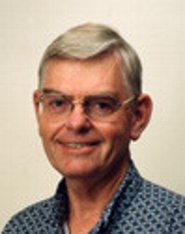
Cyanobacteria, or blue-green algae, are found in both fresh water and salt water. They form the pond scum, the algal mats and often the “blooms” that form in some lakes and in the ocean. These organisms often produce compounds that are toxic to wildlife and sometimes to humans. On the other hand, cyanobacteria also produce compounds that have promising medicinal properties, and detecting the presence of these desirable metabolites is often difficult.
By culturing cyanobacteria in a medium containing 15N, a heavy isotope of nitrogen, and using mass spectrometry, it’s possible to examine the algal filaments for compounds that have incorporated the isotope. Using this technique, a new, active metabolite called cryptomaldamide was discovered by Robin Kinnel, the Silas D. Childs Professor of Chemistry Emeritus, while he was on leave at Scripps Institute of Oceanography during the spring semester.
The identification of this new metabolite provided a powerful proof of principle: that one can look for new molecules using the mass spectrometric technique on the native cyanobacterium grown using a heavy isotope of nitrogen and subsequently isolate them. They can have promising medicinal qualities.
Until now, the usual screen for natural products involves something more complex. One collects or cultures a modest amount of the source, in this case the cyanobacteria, makes an extraction and does a preliminary separation into, say, six fractions, then tests for a particular activity, perhaps anticancer activity. This involves a greater investment in both time and money, and avoiding that can accelerate the process of drug discovery. It can also reveal compounds whose activity may not be observable using the usual procedure, or compounds that weren't even extracted by using the usual protocol.
This summer Kinnel is pursuing the synthesis of cryptomaldamide. The synthesis of cryptomaldamide will accomplish several goals. First, it will confirm the structure that has been proposed on the basis of spectral evidence. Second, because it will generate considerably more material than was isolated from the cyanobacteria, it can be used for testing in a wide variety of assays to find the most promising activity--perhaps affecting the opening and/or closing of calcium or sodium channels in cells, perhaps as an antibiotic, or perhaps as a new drug for treating bipolar disorder.
Kinnel is joined in his summer research by Marta Kolodziejczak. Born and raised in Poland, Kolodziejczak completed her undergraduate work at the Universite Pierre et Marie Curie in Paris, then started her master’s program at the University of Maastricht in the Netherlands. She comes to Hamilton through the Junior Year in France Program. Kolodziejczak will return to Paris in the fall to finish her master’s degree.
By culturing cyanobacteria in a medium containing 15N, a heavy isotope of nitrogen, and using mass spectrometry, it’s possible to examine the algal filaments for compounds that have incorporated the isotope. Using this technique, a new, active metabolite called cryptomaldamide was discovered by Robin Kinnel, the Silas D. Childs Professor of Chemistry Emeritus, while he was on leave at Scripps Institute of Oceanography during the spring semester.
The identification of this new metabolite provided a powerful proof of principle: that one can look for new molecules using the mass spectrometric technique on the native cyanobacterium grown using a heavy isotope of nitrogen and subsequently isolate them. They can have promising medicinal qualities.
Until now, the usual screen for natural products involves something more complex. One collects or cultures a modest amount of the source, in this case the cyanobacteria, makes an extraction and does a preliminary separation into, say, six fractions, then tests for a particular activity, perhaps anticancer activity. This involves a greater investment in both time and money, and avoiding that can accelerate the process of drug discovery. It can also reveal compounds whose activity may not be observable using the usual procedure, or compounds that weren't even extracted by using the usual protocol.
This summer Kinnel is pursuing the synthesis of cryptomaldamide. The synthesis of cryptomaldamide will accomplish several goals. First, it will confirm the structure that has been proposed on the basis of spectral evidence. Second, because it will generate considerably more material than was isolated from the cyanobacteria, it can be used for testing in a wide variety of assays to find the most promising activity--perhaps affecting the opening and/or closing of calcium or sodium channels in cells, perhaps as an antibiotic, or perhaps as a new drug for treating bipolar disorder.
Kinnel is joined in his summer research by Marta Kolodziejczak. Born and raised in Poland, Kolodziejczak completed her undergraduate work at the Universite Pierre et Marie Curie in Paris, then started her master’s program at the University of Maastricht in the Netherlands. She comes to Hamilton through the Junior Year in France Program. Kolodziejczak will return to Paris in the fall to finish her master’s degree.
